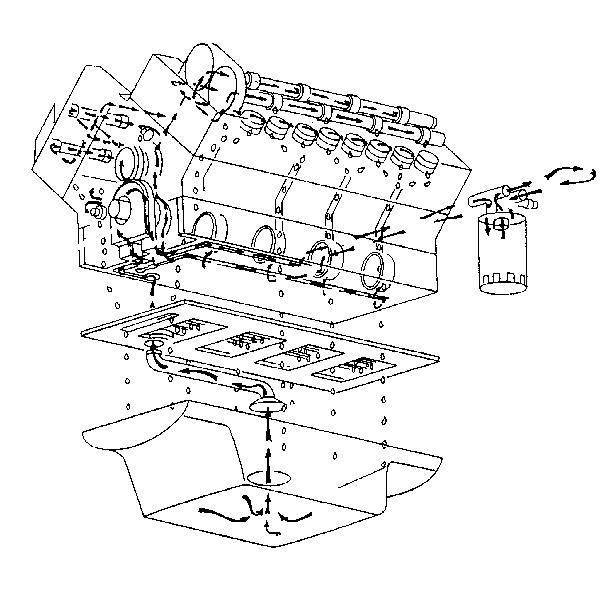Lubrication System

The cast aluminum oil pan is used as a structural member of the powertrain by connecting the pan and the transaxle case together with a bracket. The oil pan incorporates riveted internal oil baffle plates and seals to the lower crankcase with an O-ring gasket. The oil pan also provides mounting for an oil level sensor.
The oil sump pickup is fastened to the lower crankcase and oil manifold by a bolt and nut to one stud-headed main bearing bolt. A silicone seal, integral to the oil manifold, seals this joint on the suction side of the oil system. The engine oil pump is a gerotor design mounted to the lower crankcase behind the engine front cover by three mounting bolts. Drive for the gerotor elements is provided by the clamp load of the harmonic dampener and bolt. As the pump rotates, oil is drawn from the sump through the sump pickup to a channel cast into the lower crankcase. The oil is then directed to the pump inlet cavity on the lower crankcase front face. Oil compressed by the pump re-enters the lower crankcase distribution channel through the pump outlet cavity opposite the inlet. A portion of the pump output is diverted via an internal passage to the oil pump inlet to provide a pressure seal at the crankcase interface.
The oil pump outlet channel in the lower crankcase routes the oil to the oil filter/cooler circuit connections on the (front/left) side of the lower crankcase.
The cast aluminum oil filter adapter is fastened to the crankcase with two bolts. The inlet and return passages are sealed with O-rings. The adapter contains the oil pressure switch and two non-serviceable bypass valves. The oil filter bypass valve routes oil directly from the filter inlet to the filter outlet if the filter becomes plugged.
During normal operation oil flows from the adapter inlet through the oil filter. At this point oil flow is controlled by the oil cooler valve. This valve is closed when below its calibrated value and directs the oil filter output to the oil cooler located in the left hand radiator tank. Above the calibrated value the valve unseats and allows some of the oil to bypass the cooler and flow directly to the adapters return passage. Filtered and cooled oil re-enters the crankcase distribution channels and is simultaneously directed to the main bearings. Cross drilled passages in the crankshaft in turn provide oil for the connecting rod bearings and provide splash oiling for the cylinder walls. The lower crankcase distribution channel also connects with passages in the upper crankcase to provide oil to the overhead camshafts and valve lifters. This passage, beside the number one bearing, also provides oil for the three hydraulic chain tensioners as well as lubrication for the cam drive intermediate shaft ultimately lubricating the cam chains via oil splash.
Oil for the camshafts and valve mechanisms enters each cylinder head through passages in the upper crankcase below the front camshaft bearing. Oil then enters the camshaft through a drilled passage and travels through the hollow camshafts for delivery to the remainder of the cam bearings. The same cylinder head passage that supplies the camshafts also intersects a longitudinal gallery for each group of valve lifters (intake and exhaust).
Oil returns to the sump either through the cam chain area or by way of cast oil drain back passages on the outside walls of the cylinder heads, upper and lower crankcases and oil pan. The lubrication system also includes a baffle, attached by the main bearing bolts, and channels oil thrown from the crankshaft back into the oil sump.
